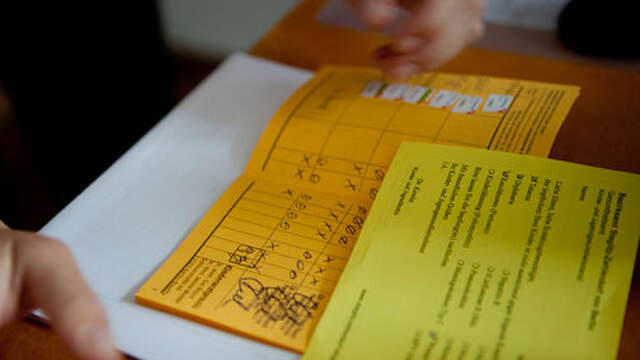
Detailed Information on the Screenings
A closer look.
When is which screening due? And what does it include? On this page, we have summarised what exactly to expect from the paediatric screenings and when they should take place.
| Name | Age | Examinations |
|---|---|---|
| APGAR | An evaluation based on the Apgar score. | |
| U1 | This examination includes the measuring and weighing of the baby, as well as the examination of the blood of the umbilical cord. | |
| U2 | Usually the U2 is still performed in hospital. It includes the assessment of skin, organs, genitals, and a blood sample is taken to screen for various congenital treatable metabolic diseases and hormonal disorders. In recent years, a hearing test has also become part of the examination concept, since early detection of a hearing disorder offers the possibility of sustainably supporting the affected child in its social and emotional development and avoiding language development disorders. Usually, the paediatrician also provides information on rickets and caries prophylaxis with vitamin D preparations and and provides information on the ideal sleeping environment to prevent sudden infant death as part of this examination. | |
| U3 | The U3 usually is the first examination carried out by your own paediatrician. The examination of bodily functions, hearing and the so-called newborn hip screening are among its components. This includes referral for sonography of both hips (hip ultrasound) in order to diagnose possible hip dysplasia (in 1 - 3% of all newborns). During the consultation, a possible disease of the bile ducts is excluded on the basis of a so-called stool colour chart. Upcoming vaccinations will also be discussed during the U3. | |
| U4 | As in all screenings, including the U3, a thorough physical examination is performed. In the U4 special attention is given to the infant’s motor development, for example head control when lifting the child, the head’s position while lying on its tummy, hand-mouth hand-hand contact, (the beginning of) grasping and speech development and vision. | |
| U5 | Mobility and physical control are of special importance at this age: Can the child already support itself on its arms and pull itself up? Is it able to hold its own head and reach for objects? Hearing and eye sight are also checked again as part of the U5, as well an assessment of speech development. Upcoming vaccinations, the introduction of supplementary food and UV protection also play a part in the U5 screening. | |
| U6 | In addition to the general examinations of the bodily functions, special attention is again given to testing the mobility and body control. We will check whether the child can already sit freely with stretched legs and a straight back or even stand alone while holding on tight to something or someone. The linguistic development will be evaluated by observation or through questioning the parents. The assessment of vision is also part of this examination. Other points of interest during the U6 screening are often nutrition, drinking at night and upcoming vaccinations. | |
| U7 | In addition to the general examinations of bodily functions (incl. eyesight), the focus is now mainly on the examination of mental development. Is the child already capable of forming two-word sentences, naming familiar objects and understanding simple prompts? The fine and gross motor development is checked by means of small tests. The child’s play behaviour, independence, care situation, eating and sleeping behaviour as well as possibly missed and pending vaccinations are also discussed with its parents. | |
| U7a | The U7a screening is mainly concerned with the detection and possible treatment of allergic diseases, socialisation and behavioural difficulties, obesity, language development disorders, dental, oral and jaw anomalies. | |
| U8 | The U8 screening examines the child’s mobility and coordination skills as well as reflexes, muscle strength, pronunciation and dental condition. | |
| U9 | The U9 screening should take place in the year before school starts and is therefore particularly important. It again includes tests of coordination (gross and fine motor skills), speech comprehension, as well as hearing and vision. | |
| U10 | The U10 and the U11 screenings fill the long period between the U9 (at about 5 years of age) and J1 (at about 12 to 14 years of age). The detection and treatment of possible developmental disorders (e.g. reading, spelling and arithmetic disorders), impairment of motor development and behavioural disorders (e.g. ADHD) are part of this screening. | |
| U11 | In the U11 screening, special attention is given to possible difficulties in school performance, social skills, behaviour, dental, oral and jaw anomalies and possibly health-endagering media behaviour. Among other matters, the screening is intended to promote physical activity and sport and to identify and help prevent substance abuse, but also to support healthy life choices (e.g. nutrition, physical activity, stress, addiction and media advice). | |
| J1 | The second to last examination of the “U-series” is the J1 (youth health examination). In this screening, the vaccination status, struma prophylaxis, blood pressure, special family situations, health behaviour, school development, motor skills and possible posture anomalies are recorded. Pubertal development and sexual behaviour will also be discussed. | |
| J2 | The last screening J2 is centered around the following topics: Recognition and treatment of pubertal and sexual disorders, posture disorders, goiter formation, diabetes prevention, social and behavioral disorders. Advice on career choices can also be part of this examination. |
*) The costs for this service are not covered by all health insurance companies.